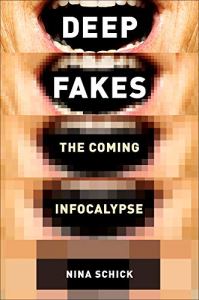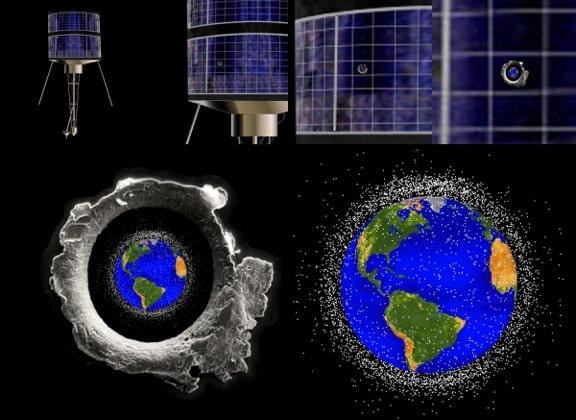- Are we moving towards a world without truth?
Due to the rise of social media, information bubbles and the possibilities of Deepfakes, we no longer live in a shared reality. How further? We live in an “infocalypse,” says British disinformation expert Nina Schick. In her book Deepfakes and the Infocalypse – What You Urgently Need to Know, she sketches a society that is overrun by too much information, whereby no distinction can be made between ‘information’ and ‘disinformation’.
In this virtual briefing with WIRED editor Greg Williams and Nina Schick, political broadcaster and author of Deep Fakes and the Infocalypse, they explore the rise of fake news and the disturbingly outsized impact this type of misinformation has on how we think and behave – and on what we believe. “If you look at how corrupt our information ecosystem has become, deepfakes didn’t emerge in a vacuum – what we’re actually seeing is how the age of information and all the rapid exponential technological advances attached to the age of information which have had many positive benefits, also have a darker underbelly.” says Schick in this 25-minute briefing. Designed as an extension of WIRED’s long-running live conference portfolio, these punchy, deliberate and engaging sessions reflect the same high calibre of speakers and programming featured at a WIRED event.
 Book Excerpt
Book Excerpt
From Deepfakes by Nina Schick
There is a viral video of President Obama on YouTube, with almost 7.5 million views. The title lures you in: “You Won’t Believe What Obama Says In This Video!”
Obama looks straight into the camera. Seated in a deep mahogany chair, he appears to be in the Oval Office. He’s aged – you can tell from his salt-and-pepper hair. But he looks confident, relaxed. Over his right shoulder, you catch a glimpse of the American flag. As usual, Obama is dressed impeccably: a crisp white shirt and a blue tie. On his left lapel, he’s sporting a US-flag pin.
You click play. “We’re entering an era in which our enemies can make it look like anyone is saying anything in any point in time,” Obama begins. “Even if they would never say those things. So, for instance…” he continues, gesturing with his hands, “they could have me say things like President Trump is a total and complete dipshit!” His eyes seem to glimmer with a hint of a smile. Obama continues: “Now, you see, I would never say these things, at least not in a public address.”
Obama never did say those things. The video was fake – a so-called ‘deepfake’, created with the help of Artificial Intelligence (AI).
Welcome to the future, one in which AI is getting powerful enough to make people say things they never said and do things they never did. Anyone can be targeted, and everyone can deny everything. In our broken information ecosystem – characterized by misinformation and disinformation – AI and deepfakes are the latest evolving threat.
- Spatial Horizontality thinking:

Illustrating the technosphere’s expansion requires that technology be considered through representations of the technosphere as an infrastructural or networked whole. Examples of these are gas pipelines, intercontinental food freighting, and instant communication using an Internet connection. If the technology is networked into a flow of energy and matter, it is not only a thing unto itself but also represents a systemic component of the technosphere. The horizontal movement of technology across the Earth’s surface demonstrates both the magnitude of systemic interconnections and, correspondingly, the difficulty of distinguishing human agency in the extraction of energy and matter when the expansion spans great distances with effects on several environments.
What is a deepfake?
A deepfake is a type of ‘synthetic media,’ meaning media (including images, audio and video) that is either manipulated or wholly generated by AI.
Technology has consistently made the manipulation of media easier and more accessible (ie through tools like Photoshop and Instagram filters). But recent advances in AI are going to take it further still, by giving machines the power to generate wholly synthetic media. This will have huge implications on how we produce content, and how we communicate and interpret the world. This technology is still nascent, but in a few years’ time anyone with a smartphone will be able to produce Hollywood-level special effects at next to no cost, with minimum skill or effort.
While this will have many positive applications – movies and computer games are going to become ever more spectacular – it will also be used as a weapon.
When used maliciously as disinformation, or when used as misinformation, a piece of synthetic media is called a ‘deepfake’. This is my definition for the word. Because this field is still so new, there is still no consensus on the taxonomy. However, because there are positive as well as negative uses-cases for synthetic media, I distinguish a ‘deepfake’ specifically as any synthetic media that is used for mis- and disinformation purposes.
The Obama YouTube video was produced by the Hollywood Director Jordan Peele and Buzzfeed, and was intended to be educational, serving as a warning for these potential negative use cases of synthetic media.
As ‘Obama’ goes on to say, “Moving forward we need to be more vigilant with what we trust on the Internet. It may sound basic, but how we move forward in the Age of Information is going to be the difference between whether we survive or if we become some fucked-up dystopia.”
With the advent of social media, different groups in our society have the tendency to increasingly withdraw into their own ‘echo rooms.’ In this they experience their own ‘subjective truth.’ This makes it increasingly difficult to reach a consensus on how the ‘real’ world should be seen. A new effective and influential step in the dissemination of dis- and misinformation is the emergence of synthetic media.
How do synthetic media change our perception of reality?
Deek fakes are computer and artificial intelligence (A.I.) generated audio and / or video fragments that can no longer be distinguished from “real”. In this context, consider the video of the British Queen Elizabeth, who (initially) gave a serious Christmas speech but later ended up dancing on the tables of Buckingham Palace. In this broadcast, VPRO Tegenlicht investigates what is ‘real’ and what is ‘fake’. And what role synthetic media play in our experience of “reality”. An exploration of the future with three prominent thinkers in which both the dangers and the positive potential of these media are discussed. In this context, think of deep fake as a therapy and as a new artistic form of expression.
- The Transhumanist Fallacy
By M. Ali LakhaniAnd
Satan whispered unto him and said: ‘O Adam, shall I show thee the Tree of Immortality and a kingdom that fadeth not away?’ — Qur’an, XX: 120
‘...machines cannot overtake human intelligence, but men surely can relinquish their original condition, repudiate their intelligence and willingly surrender to technology’s artifice; they can, indeed, reach such a point of stultification as to reduce their consciousness to the level of computer data, and, on comparing the two machines, there is no doubt, the computer is more capable.’ – Agustín López Tobajas, Manifesto Against Progress
In the last few decades, our world has been revolutionized by inventions such as the internet, the tablet and the smartphone. According to some claims, it is now bracing for the next, and, it is anticipated, more profound, technological revolution — transhumanism, the convergence of nanotechnology, biotechnology, information technology and cognitive science (NBIC) which is expected to usher in what is being termed the ‘Transhuman Era’, one that will blur the distinction between man and machine, and radically redefine what it means to be human. In fact it is being asserted that this new era has already dawned. In August 2018, Forbes proclaimed its advent and cautioned that its emerging technologies, while ‘saving lives, extending lives and even redefining life’, will raise many new ethical challenges.
What is ‘transhumanism’? Denoted by the sign ‘H+’, transhumanism can be defined as the ideology which seeks to modify or improve the human race and overcome its biological limitations by, for instance, prolonging human life or otherwise ‘augmenting’ the human organ‑ism through NBIC technologies such as gene therapy and cybernetic engineering. Though the concepts underlying the ideology are older, the term ‘transhumanism’ itself came to prominence in a 1957 essay by Sir Julian Huxley, in which he outlined its key aim — the ‘transcendence’ of the human species.Read more here
